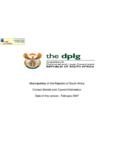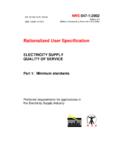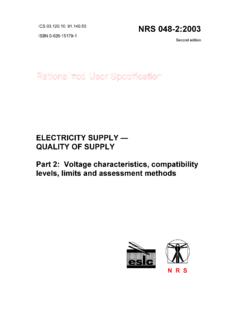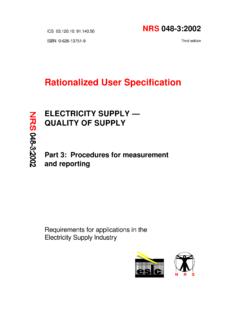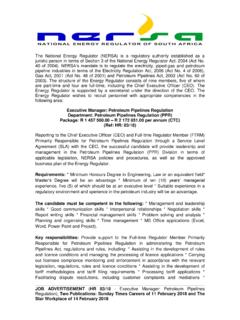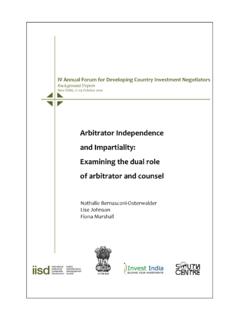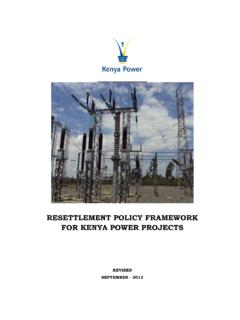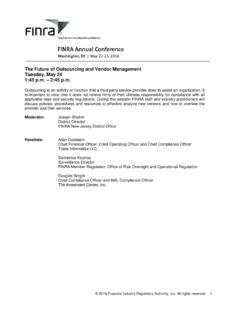Transcription of The Purpose of Economic Regulation and Role of NERSA in ...
1 1 The Purpose of Economic Regulation and Role of NERSA in the Energy Sector RegulationPresentation to: South Africa Economic Regulators Conference (SAERC)By: Phindile Nzimande, CEO, NERSA21 August of Economic Regulation Public Interest Theory vs Capture of Credible Regulation Policy; Legislation; Regulator Institutional Arrangements in SA Juristic Person; Departmental; Self of NERSA in the Regulation of Energy of Regulation in South In our current South Africa infrastructure investment mode, one challenge is that of establishing credible regulatory regime (commitment) necessary for attracting sufficient funds to make the required infrastructure investments A credible regulatory commitment provides a regulated entity with assurance that, after having made the investments, it will be allowed to provide services at prices that fully recover efficient investment costs and makes a profit commensurate with riskIntroduction4 A second challenge is that of ensuring the regulated services are accessible, available (service reliability)
2 , and affordable to the South Africans This presentation explores the Purpose of Regulation and the role of NERSA in the Energy Sector Regulation in that contextIntroduction5 Commonly held view is that Regulation is for the public good (the public interest theory) Regulatory intervention is necessitated by market failure Market failure manifests itself in the form of market monopoly power Intent of Regulation is to create an imitative substitute of competition to exact efficiencies from these monopolistic market structurePurpose of Economic Regulation =Public Interest6 Regulation for the public good aims to strike a balance between the interests of society by treating both the regulated entity s customers and the regulated entity s investors fairly Regulation of monopolies for the public good therefore furthers public objectives and maximises social welfarePurpose of Economic Regulation =Public Interest7 Public interest theory, that Regulation is for the public good, is criticised by the Capture Theory for its.
3 - underestimation of the lobbying power of organised interests/regulated entity inability to take into account that there is no universal agreement on what is public good or public interest Criticism of Public Interest view=Capture Theory8 Capture theory view contends that:- the real Purpose of natural monopoly Regulation is to serve Economic interests of the monopolies themselves consumers rarely have an incentive to take action against the regulator, so long as the costs imposed on the rest of the society are small enough, even though it reduces Economic welfare Regulation is driven not by efficiency but by politics politicians establish commissions to take shelter from hard decisions dealing with politically sensitive Economic issuesCriticism of Public Interest view=Capture Theory9 Despite these criticisms of the public interest view, the Regulation of natural monopolies still remains Arguments to counter the Capture Theory include.
4 - no single Economic interest group captures the regulatory body natural monopoly Regulation is not evidently in the interest of regulated firms, as it seems to place an upper limit, rather than a floor, on the prices the regulated firm can charge Governments delegate decision-making powers to these bodies, in part, to preserve public confidence in the fairness of the decision-making processRegulation of Natural Monopolies Still Remains10 Response to the criticisms against public interest:- a roll-back in Economic Regulation , and establishment of new mechanisms (such as requirements for all new Regulation to pass an Economic cost-benefit test) to prevent inefficient regulations being implemented in futureLessons learned from the Capture Theory11 To prevent regulatory capture, the policy makers can make changes in the design or the regulatory institutions such as.
5 - changes in the length of the regulator s tenure changes in the design of the regulatory tasks ex-parte communication rules However in making these changes, policy makers should also guard against their tendency to reduce regulatory discretion to the extent of making day-to-day regulatory operations a routine learned from the Capture Theory12 Policy signals the intent of government with respect to Regulation Policy clarifies the roles and responsibilities of the regulator in implementing policy The South African White Paper on Energy Policy (1998), Policy Objective No. 2 provided for the creation for Energy Regulator:- Improving energy governance: -The focus will be the clarification of roles and responsibilities of the various governance institutions, such as the Energy Regulator, Government departments and other spheres of government, as well as consultation with stakeholders on the formulation and implementation of energy policies Enabler of credible Regulation : Policy13 Policy should give Economic regulators discretion in executing their mandate, but that role should be restricted to implementing public policy, rather than making it.
6 , In the case of NERSA , the enabling legislation requires NERSA to make decisions that are not at variance with published government policyEnabler of credible Regulation : Policy14 Thin line between policy making and Regulation since it is also possible to confuse a regulatory decision for policy-making . Encapsulated in the comment:- ..this is not to say that regulators are not tempted to make policy, but regulators have traditionally walked and must continue to walk, the fine line between pandering to public opinion and recognizing that decisions that lack broad public support (at least of the process by which those decisions were reached) are ultimately not (Senator Pat Moynihan 1998). Enabler of credible Regulation : Policy15 The mandate of the regulator is spelt out in enabling legislation For credible Regulation , legislation should compel the Economic regulator to act :- according to the constitution and the laws of the country transparently, follow administrative justice procedures and provide the public with access to the informationEnabler of credible Regulation : Legislation16 Legislation must specify how the regulator raises its budget and accountability framework to the executive, legislature, judiciary and on the management of its financial affairs Regulator should be allowed to raise its budget from a fee (levy) imposed on licensees to create financial autonomy.
7 Without this financial autonomy, the regulator s ability to execute its mandate will vary from budget cycle to budget of credible Regulation : Legislation17 Regulatory independence is a necessary element in providing stakeholders with confidence in the regulatory system But what is regulatory independence? ..the degree of independence from government varies with the type of (Caron 2012) ..no agency head can ever achieve complete autonomy for his or her organization; politics require accountability, and democratic politics implies a particularly complex and all-encompassing pattern of accountability (Wilson 1989)Enabler of credible Regulation : Independence18 Regulatory independence is a durable balance between authorityand accountability Authorityrequires that a regulator have the authority to make independent decisions consistent with its designated mandate Accountabilityto the executive, legislature, judiciary for oversight of the regulator to ensure that the regulator performs its assigned tasks in the public good.
8 A regulatory body is accountable for their decision in a court of law if taken for review, and accountability on the management of its financial affairsEnabler of credible Regulation : Independence19 But, ultimately regulatory independence comes down to societal and policy makers attitudes to regulationEnabler of credible Regulation : Independence20 In South Africa, we observe three institutional arrangements of how Economic regulators are organised. These are: a juristic persons , NERSA , ICASA in-house regulators within a government department., Transport Regulator, Water Regulator industry self-regulationSouth Africa Regulatory Institutional Arrangements21 NERSA is a regulatory authority established as a juristic person in terms of Section 3 of the National Energy Regulator Act, 2004 (Act No.)
9 40 of 2004) NERSA regulates the:- Electricity industry in terms of the Electricity Regulation Act, 2006 (Act No. 4 of 2006) Piped-Gas industry in terms of Gas Act, 2001 (Act No. 48 of 2001); and the Petroleum Pipeline industry in terms of the Petroleum Pipelines Act, 2003 (Act No. 60 of 2003)Role of NERSA : Legal Basis and Mandate22 NERSA decision-making and public participatory processes are conducted under the Promotion of Administrative Justice Act, 2000 (Act No. 3 of 2000) (PAJA) NERSA determines how to treat access to information under the Promotion of Access to Information Act, 2000 (Act No. 2 of 2000) (PAIA) NERSA s funding is through levies paid by the regulated entities under the three industries respective Levies Acts. NERSA conducts its financial affairs in accordance with the Public Finance Management Act, 1999 (Act No.
10 1 of 1999) (PFMA)Role of NERSA : Legal Basis and Mandate23 Licensing and Registrations Pricing and tariffs Promoting competition Compliance monitoring and dispute resolution Gathering information Role of NERSA : Functions24 NERSA has published rules and procedures for conduct of its meeting and public participation processes; All of the Energy Regulator s meetings are open to the public; All of the Energy Regulator meetings are advertised;Role of NERSA : How NERSA exercises its mandate25 NERSA has published methodologies for tariffs/price setting/approvals; Methodologies aim to enable an efficient licensees make a profit commensurate with risk Ensure that products and service are accessible, available and affordable to the publicRole of NERSA : How NERSA exercises its mandate26 NERSA s decision-making processes follow the required administrative justice procedures and abide by:- Follow due process with transparent public consultations in making its decisions Make decisions based on facts and evidence and must be in writing Make decisions that are not at variance with published government policyRole of NERSA : How NERSA exercises its mandate27 Any of the Energy Regulator s decisions can be taken for review at the High CourtRole of NERSA .
